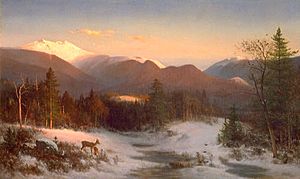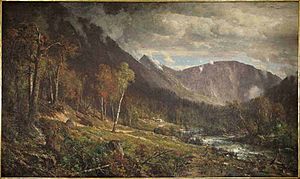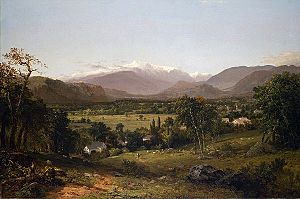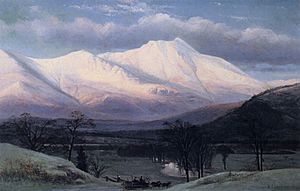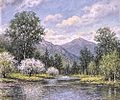White Mountain art facts for kids
White Mountain art is a collection of paintings made in the 1800s by over 400 artists. These artists painted beautiful scenes of the White Mountains in New Hampshire. They wanted to show how amazing the area was and, of course, sell their artwork.
In the early 1800s, artists started going to the White Mountains to sketch and paint. Many were drawn to the area after a sad event in 1826. Nine people from the Willey family died in a huge mudslide. These first paintings showed a wild and dramatic mountain wilderness. For example, a painting by Thomas Cole (1801–1848) called Distant View of the Slide that Destroyed the Willey Family showed broken trees and rocks, with a storm brewing. This made the place look wild and lonely. These pictures captured the imagination of people, especially those from big cities in the Northeast. They traveled to the White Mountains to see these scenes for themselves. Soon, more people followed: hotel owners, writers, scientists, and even more artists. The White Mountains became a very popular place for tourists from New England and beyond. Paintings and prints of the area allowed people who couldn't visit to enjoy its beauty.
As more people visited, transportation to the region got better. Inns and large resort hotels were built, and some even had artists living there. Benjamin Champney (1817–1907), one of the first artists, helped make the Conway Valley famous. Other artists liked the Franconia area, while some explored Gorham, Shelburne, and towns further north. Even though these artists painted similar scenes, each had their own special style. However, these landscape paintings, which were part of the Hudson River School style, eventually became less popular. By the early 1900s, the time for White Mountain art had ended.
Contents
The Willey Family Tragedy
On August 28, 1826, heavy rains in the White Mountains caused a huge mudslide on Mount Willey. The Willey family, with their five children, lived in a small house in Crawford Notch. This is a mountain pass between Mounts Willey and Webster. The family tried to escape their home with the help of two workers, but all nine people died in the landslide. Amazingly, the Willey home was left standing. Rescuers later found an open Bible on a table inside, showing that the family left very quickly.
News of the Willey tragedy spread fast across the country. In the years that followed, it became a topic for stories, drawings, local histories, science papers, and paintings. For example, Thomas Hill (1829–1908) painted Crawford Notch, showing the area before the slide. The Willey disaster made people more aware of the wild and untamed nature of the American landscape in the White Mountains.
This mix of tragedy and wild nature strongly attracted early artists to the White Mountains. Thomas Cole wrote in his diary in 1828, "The site of the Willey House, with its little patch of green in the gloomy desolation, very naturally recalled to mind the horrors of the night when the whole family perished beneath an avalanche of rocks and earth." The event also inspired a story by Nathaniel Hawthorne in 1835 called "The Ambitious Guest".
Early Artists and Their Work
In 1827, Thomas Cole was one of the first artists to sketch in the White Mountains. He started a painting style later called the Hudson River School. Cole's 1839 painting, A View of the Pass Called the Notch of the White Mountains, is a great example of early White Mountain art. It's considered one of the best paintings of the White Mountains. Two other early painters were Alvan Fisher (1792–1863) and Thomas Doughty (1793–1856) from Massachusetts. Their paintings showed dramatic landscapes and how small humans seemed compared to nature. These artworks helped make the White Mountains famous when it was still a wild, unknown place.
Starting in the 1830s, Hudson River School painters wanted to show what America was all about. They saw themselves as explorers, creating art that expressed important American ideas.
In 1851, John Frederick Kensett (1816–1872) created a large painting of Mount Washington. This painting became one of the best examples of later White Mountain art. It was called Mount Washington from the Valley of Conway. Kensett's painting became a very effective advertisement for the beautiful scenery of the White Mountains, especially North Conway. The painting was bought by the American Art-Union and turned into a print. Over 13,000 copies were sent to people across the country. Many artists copied this scene from the print, and Currier and Ives even made a lithograph (a type of print) of it in 1860. Kensett's painting really helped make the region popular.
Because Boston was close to the White Mountains, artists from that city were the main visitors. They came to paint the mountain views. Starting with Benjamin Champney in 1838, his friends and other artists traveled to the mountains throughout the 1800s. In 1854, these artists, including Francis Seth Frost (1825–1902) and Samuel Lancaster Gerry (1813–1891), helped start the Boston Art Club. For many years, this club was a place to see White Mountain paintings.
Getting to the Mountains
Traveling to the White Mountains in the early days took a long time. Before trains, a stagecoach ride from Portland, Maine, to Conway, New Hampshire, about 50 miles, took a whole day. But when the St. Lawrence and Atlantic Railroad finished its route from Portland to Gorham in 1851, tourists and artists could travel to the White Mountains much more comfortably. They were then only about 8 miles from Mount Washington and the Glen House hotel.
Even though train lines to North Conway weren't finished until the early 1870s, a local innkeeper named Samuel Thompson started coach service from Conway to North Conway. Thompson also encouraged artists to visit North Conway to help promote the area. In the early 1850s, Thompson convinced a young artist, Benjamin Champney, to come to North Conway.
Benjamin Champney and North Conway
Benjamin Champney, who was from New Hampshire, first visited the White Mountains in 1838. As an artist in the mid-1800s, Champney's style was influenced by the Hudson River School, but he also developed his own unique way of painting.
In 1853, Champney bought a home in North Conway. He spent the rest of his life painting in the greater Conway area. He invited other artists to the region and opened his studio to them and to tourists. Champney wrote in his autobiography in 1900 that his studio was visited by many educated people from all over the country and even from other lands. He enjoyed sharing ideas with them. He also described how popular North Conway became: "Every year brought fresh visitors to North Conway as the news of its attractions spread, until in 1853 and 1854 the meadows and the banks of the Saco were dotted all about with white umbrellas in great numbers."
Thanks largely to Champney's efforts, many artists traveled to North Conway in the summer to paint. The area was full of artists painting outdoors, a style called en plein air. By 1855, North Conway had become "the pet valley of our landscape painters." It was said that you could hardly look across the meadows without seeing one of their white umbrellas shining in the sun. By the 1850s, North Conway was likely the first artist colony in the United States. Winslow Homer (1836–1910) even showed these artists in his 1868 painting called Artists Sketching in the White Mountains.
Later Artists and Their Styles
More than 400 artists are known to have painted White Mountain scenes during the 1800s. They came from places like Boston, Maine, Pennsylvania, and New York. Most of the Hudson River School painters worked in the White Mountains but kept their main studios in New York City. This included famous artists like Sanford Robinson Gifford (1823–1880) and Jasper Francis Cropsey (1823–1900).
Most artists visited the White Mountains in the summer. They would then return to their city studios or go to warmer places like Florida in the winter. Because of this, paintings of winter scenes are not very common. A few artists, like Champney, Edward Hill (1843–1923), and Edward's brother, Thomas Hill, sometimes painted these rare winter scenes. Two examples are Thomas Hill's Mount Lafayette in Winter and Benjamin Champney's Moat Mountain from North Conway, both shown in this article. Frank Henry Shapleigh (1842–1906) had a home in Jackson and painted many New Hampshire scenes, both in summer and winter.
By the middle of the 1800s, later painters started to change their style. Instead of idealized views, they painted more realistic scenes of the mountains. These more detailed views were popular with tourists who wanted souvenirs of their travels before photography became common. For example, a painting by George Albert Frost (1843–1907) of Franconia Notch from 1883 looks very similar to a photograph of the same scene taken in 2004.
Grand Resort Hotels
In the 1860s, many large resort hotels were built in the White Mountains. They became popular summer spots for wealthy city people from Boston, New York, and Philadelphia. By 1865, so many tourists were coming that all the hotels were completely full. During the second half of the 1800s, many artists lived at these grand hotels. They were known as "artists-in-residence." This was good for both the artist and the hotel. The artists invited guests to their studios to see their work. Guests bought original paintings to take home as memories of the White Mountains. The hotel benefited by having another attraction to make guests stay longer.
Two well-known artists-in-residence were Edward Hill and Frank Henry Shapleigh. Hill worked at the Profile House in Franconia Notch for fifteen years, from 1877 to 1892. Frank Shapleigh was the artist-in-residence at the Crawford House in Crawford Notch for sixteen years, from 1877 to 1893.
Painting in Different Areas
North Conway, with its special location in the southern Mount Washington Valley, was a favorite meeting place for many artists. The artist Asher B. Durand (1796–1886) described North Conway's appeal in a letter in 1855:
"Mount Washington, the main feature of the scene, ... rises in all his majesty, and with his contemporary patriots, Adams, Jefferson, Monroe, bounds the view at the North. On either hand, smaller mountains and ledges slope, or suddenly drop to the fertile plain that borders the Saco, stretching many miles southward, rich in varying shades of green fields and meadows, and beautifully mixed with groves and scattered trees of graceful form and deepest green ... where every possible shade of green is harmoniously blended."
A favorite spot in North Conway for viewing and painting Mount Washington was Sunset Hill. In 1858, Champney painted Mount Washington from Sunset Hill, which looked down on his own house and across North Conway's Intervale. North Conway also offered great views of other often-painted mountains like Moat Mountain, Kearsarge North, and Mount Chocorua. North Conway was also close to two of the three main mountain passes: Pinkham Notch and Crawford Notch.
Many artists also traveled to the third pass, Franconia Notch, to paint. A friendly competition grew between the artists in Franconia and those in North Conway. Each group believed their location had the most beautiful mountain views. Those who preferred Franconia felt that North Conway, by 1857, had become too crowded with tourists.
In the Franconia region, artists painted Mount Lafayette, Franconia Notch, Eagle Cliff, and New Hampshire's famous landmark, the Old Man of the Mountain. Edward Hill, George McConnell, and Samuel Lancaster Gerry all painted the Old Man. Fewer artists worked north of the Presidential Range. Those who did painted less famous scenes from Shelburne, Gorham, and Jefferson. These places were located along train or coach routes from Gorham and Franconia. The Northern Presidentials, shown above, is an example of a painting of the Presidential Range from the north.
Artist Characteristics
Each White Mountain artist had special ways of painting that made their work stand out. These unique styles can sometimes help identify an artist even more than their signature, as signatures can be faked.
- Benjamin Champney was excellent at painting water and is known for his warm autumn colors.
- William F. Paskell (1866–1951), in his later work, used wide brushstrokes and bright colors to create a soft, impressionistic feel.
- George McConnell (1852–1929) was known for the soft, velvety look of his paintings.
- Edward Hill often painted trees that formed a canopy, framing the main part of the painting. This made many of his works feel private and peaceful.
- Many paintings by Samuel Lancaster Gerry (1813–1891) included dogs, people on horseback, and men and women in red clothes.
- Francis Seth Frost (1825–1902) was known for using small figures, wispy clouds, and an oval shape for his paintings.
- Alfred Thompson Bricher (1837–1908) was known for his quiet, calm water scenes.
- Sylvester Phelps Hodgdon (1830–1906) painted at the very beginning or end of the day – sunrise and sunset scenes – often in Franconia Notch.
- John White Allen Scott (1815–1907) often painted passing storm clouds in his skies.
- Frank Henry Shapleigh (1842–1906) had his own simple style and used the same "props" over and over. He is known for painting landscapes seen from inside a house or barn, looking out through an open door or window. Inside the room, he would include things like a ladder-back chair, a cat, a basket, a straw hat, a broom, or a tall clock.
Examples of these characteristics are shown in the image gallery below.
The End of an Era
The scenes these artists painted became famous American symbols, especially for people in New England. As tourists took these White Mountain paintings home, they spread across the country. Today, you can find these paintings as far away as California.
By the late 1800s, landscape images, like those of Mount Washington, became less popular with the public. Newer images, such as those of the Rocky Mountains, started to get more attention than the White Mountains. Also, the Hudson River School style of landscapes was replaced by new art ideas. Social and technological changes happening across the country also played a part. By the end of the 1800s, these factors, along with the rise of photography, led to the slow decline of White Mountain landscape painting. However, many of these paintings are still kept safe in private collections and public museums. You can see some of them in New Hampshire at the New Hampshire Historical Society in Concord, the Currier Museum of Art in Manchester, and the Hood Museum of Art in Hanover.
Gallery: Artist Styles
-
William F. Paskell (1866–1951)
Mount Kearsarge in Spring
Bright colors; impressionistic feeling -
Edward Hill (1843–1923)
Old Man of the Mountain
Canopy of trees frame the scene. -
Sylvester Phelps Hodgdon (1830–1906)
Profile Lake, Evening
Extremes of the day
Famous White Mountain Artists
- Albert Bierstadt
- Alfred Thompson Bricher
- George Loring Brown
- Harrison Bird Brown
- Benjamin Champney
- Thomas Cole
- Jasper Francis Cropsey
- Ann Sophia Towne Darrah
- Thomas Doughty
- Asher B. Durand
- Alvan Fisher
- Francis Seth Frost
- George Albert Frost
- Samuel Lancaster Gerry
- Sanford Robinson Gifford
- William Hart
- Edward Hill
- Thomas Hill
- Winslow Homer
- Sylvester Phelps Hodgdon
- George Inness
- David Johnson
- John Frederick Kensett
- Edmund Darch Lewis
- George Lorenzo Noyes
- Alfred T. Ordway
- William Trost Richards
- Horace Wolcott Robbins
- John White Allen Scott
- Aaron Draper Shattuck
- William Louis Sonntag
See also
 In Spanish: Arte de Las Montañas Blancas para niños
In Spanish: Arte de Las Montañas Blancas para niños


